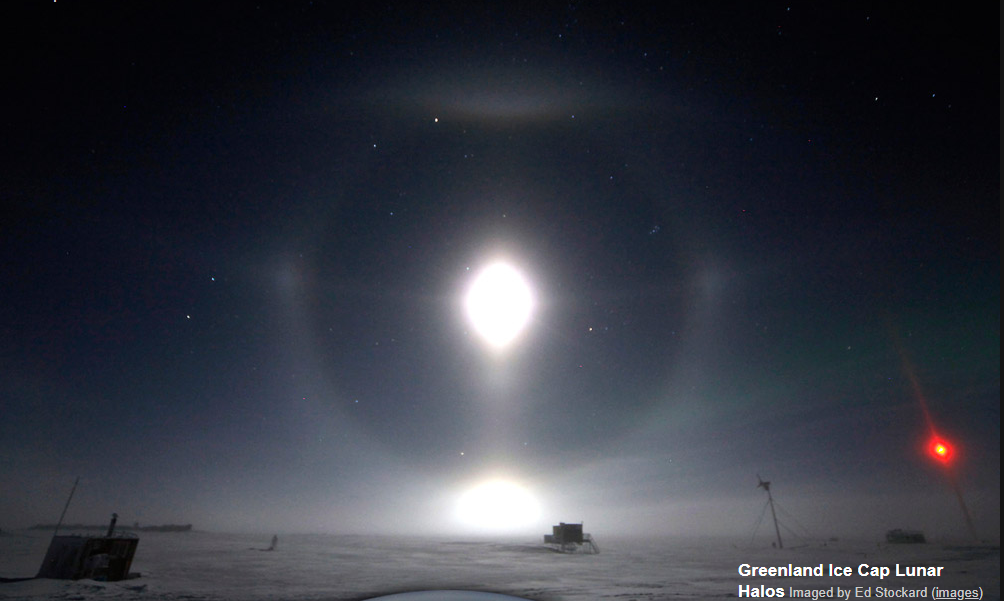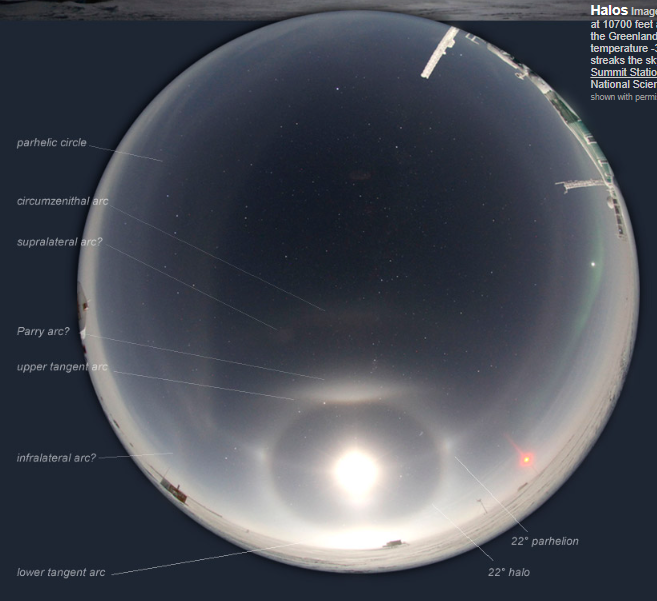OPOD - Greenland Ice Cap Halos
OPOD - Greenland Ice Cap Halos: A Stunning Atmospheric Phenomenon
Have you ever heard of the mesmerizing optical phenomenon known as halos? These enchanting displays of light occur when sunlight or moonlight interacts with ice crystals in the atmosphere, creating a breathtaking spectacle. One such remarkable occurrence took place at the peak of the Greenland ice cap on October 26, 2010, when Ed Stockard captured stunning images of lunar halos at an altitude of 10,700 feet. Let's delve into the captivating world of Greenland Ice Cap Halos and explore the beauty and science behind this atmospheric marvel.
The Icy Canvas of Greenland
Greenland, the world's largest island, is renowned for its vast ice cap that covers approximately 80% of its landmass. This icy expanse provides the perfect canvas for the formation of atmospheric phenomena like halos. The extreme cold temperatures and abundance of ice crystals in the atmosphere create optimal conditions for these dazzling displays of light.
The Enigmatic Lunar Halos
Lunar halos are a type of halo that occurs when moonlight interacts with ice crystals suspended in the air. These ice crystals act as tiny prisms, refracting and reflecting the moonlight, resulting in a ring or halo around the moon. The size and shape of the halo depend on various factors, including the size and orientation of the ice crystals.
Ed Stockard's Breathtaking Images
Ed Stockard, a talented photographer, captured the mesmerizing beauty of lunar halos at an astonishing altitude of 10,700 feet on the Greenland ice cap. Despite the harsh conditions, with temperatures plummeting to -36°C (-33°F), Stockard managed to immortalize this extraordinary atmospheric phenomenon. His images showcase the ethereal glow of the lunar halos against the backdrop of a vibrant green aurora streaking across the sky.
Summit Station: A Hub of Scientific Research
The location where Stockard captured these captivating images is Summit Station, a research facility sponsored by the US National Science Foundation. Situated on the highest point of the Greenland ice cap, this station serves as a crucial hub for scientific studies and observations in the Arctic region. Its strategic location provides scientists with a unique vantage point to study atmospheric optics and other natural phenomena.
Exploring the Science Behind Greenland Ice Cap Halos
To fully appreciate the beauty of Greenland Ice Cap Halos, it is essential to understand the science behind their formation. When moonlight passes through the hexagonal ice crystals in the atmosphere, it undergoes a process known as refraction. This refraction causes the light to change direction, resulting in the formation of a halo around the moon. The specific angles at which the light is refracted determine the size and shape of the halo.
Halo Variations: A Kaleidoscope of Light
While lunar halos are the most common type observed, they are not the only halos that can grace the skies above Greenland's ice cap. There are various other halo phenomena that can occur, each with its unique characteristics. Some of these include:
- Sun halos: Similar to lunar halos, but occurring around the sun.
- Sundogs: Bright spots of light that appear on either side of the sun.
- Circumzenithal arc: A vivid arc of colors appearing directly above the sun.
- Tangent arcs: Arcs that intersect the halo and appear tangent to it.
Unveiling the Mysteries of Greenland Ice Cap Halos
While the beauty of Greenland Ice Cap Halos is undeniable, scientists are continuously working to unravel the mysteries behind these captivating optical phenomena. By studying the size, shape, and orientation of ice crystals, researchers gain valuable insights into atmospheric conditions and processes. This knowledge contributes to our understanding of climate change, weather patterns, and the overall dynamics of our planet's atmosphere.
A Visual Symphony in the Arctic Skies
Greenland Ice Cap Halos are a testament to the awe-inspiring wonders of nature. They transform the Arctic skies into a visual symphony of light, captivating all who have the privilege to witness them. These ethereal displays remind us of the intricate interplay between light and ice crystals, showcasing the breathtaking beauty that can be found in the most remote corners of our planet.
Capturing the Beauty of Greenland Ice Cap Halos
Thanks to photographers like Ed Stockard, we can experience the magnificence of Greenland Ice Cap Halos from the comfort of our homes. Their skillful artistry allows us to marvel at the delicate dance between light and ice crystals, transporting us to a world where magic and science intertwine. Through their lenses, they bring these fleeting moments of atmospheric wonder to life, reminding us of the boundless beauty that surrounds us.
In conclusion, Greenland Ice Cap Halos are a mesmerizing atmospheric phenomenon that showcases the enchanting interaction between light and ice crystals. The images captured by Ed Stockard provide a glimpse into the captivating beauty that graces the skies above the Greenland ice cap. As we continue to explore and study these natural wonders, we deepen our understanding of the intricate workings of our atmosphere and gain a renewed appreciation for the remarkable phenomena that adorn our planet.

Greenland Ice Cap Lunar Halos Imaged by Ed Stockard (images) at 10700 feet altitude at the peak of the the Greenland ice cap October 26, 2010 - temperature -36C (-33F). A green aurora streaks the sky. The location is the site of Summit Station sponsored by the US National Science Foundation. ©Ed Stockard, shown with permission.


Note: this article has been automatically converted from the old site and may not appear as intended. You can find the original article here.
Reference Atmospheric Optics
If you use any of the definitions, information, or data presented on Atmospheric Optics, please copy the link or reference below to properly credit us as the reference source. Thank you!
-
<a href="https://atoptics.co.uk/blog/opod-greenland-ice-cap-halos/">OPOD - Greenland Ice Cap Halos</a>
-
"OPOD - Greenland Ice Cap Halos". Atmospheric Optics. Accessed on December 23, 2024. https://atoptics.co.uk/blog/opod-greenland-ice-cap-halos/.
-
"OPOD - Greenland Ice Cap Halos". Atmospheric Optics, https://atoptics.co.uk/blog/opod-greenland-ice-cap-halos/. Accessed 23 December, 2024
-
OPOD - Greenland Ice Cap Halos. Atmospheric Optics. Retrieved from https://atoptics.co.uk/blog/opod-greenland-ice-cap-halos/.